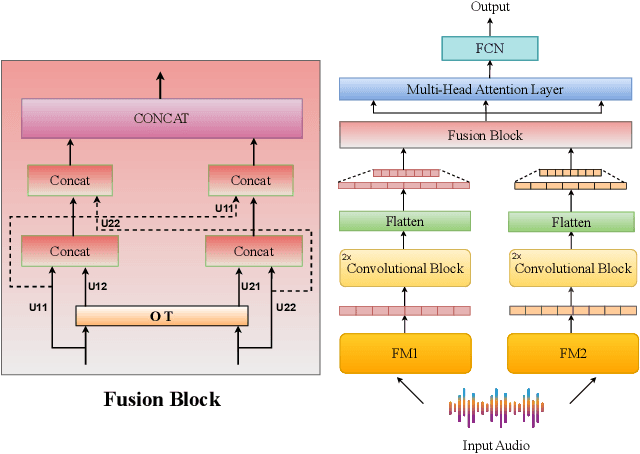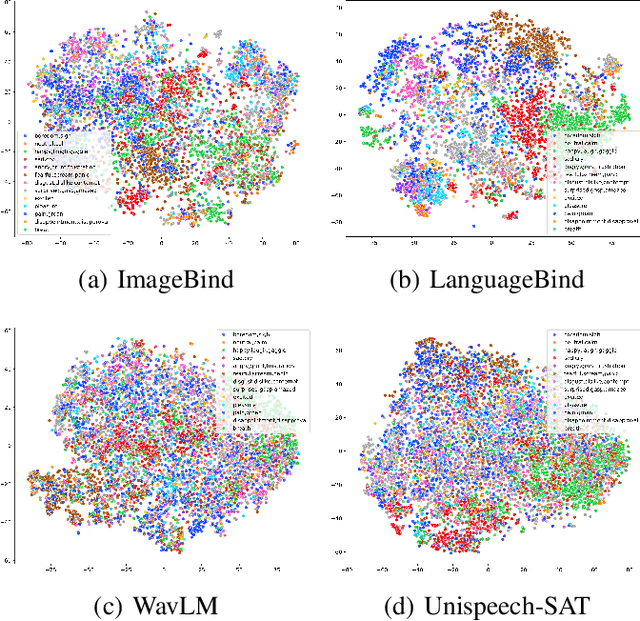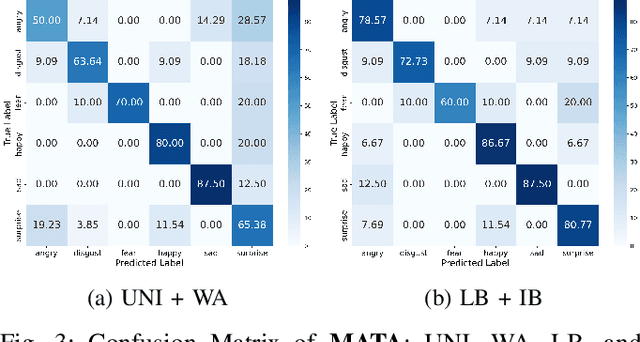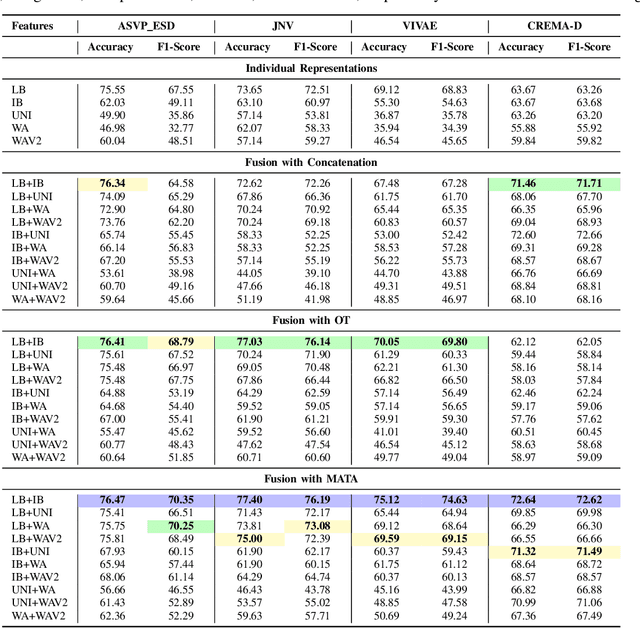Girish
Towards Neural Audio Codec Source Parsing
Jun 14, 2025Abstract:A new class of audio deepfakes-codecfakes (CFs)-has recently caught attention, synthesized by Audio Language Models that leverage neural audio codecs (NACs) in the backend. In response, the community has introduced dedicated benchmarks and tailored detection strategies. As the field advances, efforts have moved beyond binary detection toward source attribution, including open-set attribution, which aims to identify the NAC responsible for generation and flag novel, unseen ones during inference. This shift toward source attribution improves forensic interpretability and accountability. However, open-set attribution remains fundamentally limited: while it can detect that a NAC is unfamiliar, it cannot characterize or identify individual unseen codecs. It treats such inputs as generic ``unknowns'', lacking insight into their internal configuration. This leads to major shortcomings: limited generalization to new NACs and inability to resolve fine-grained variations within NAC families. To address these gaps, we propose Neural Audio Codec Source Parsing (NACSP) - a paradigm shift that reframes source attribution for CFs as structured regression over generative NAC parameters such as quantizers, bandwidth, and sampling rate. We formulate NACSP as a multi-task regression task for predicting these NAC parameters and establish the first comprehensive benchmark using various state-of-the-art speech pre-trained models (PTMs). To this end, we propose HYDRA, a novel framework that leverages hyperbolic geometry to disentangle complex latent properties from PTM representations. By employing task-specific attention over multiple curvature-aware hyperbolic subspaces, HYDRA enables superior multi-task generalization. Our extensive experiments show HYDRA achieves top results on benchmark CFs datasets compared to baselines operating in Euclidean space.
Beyond Speech and More: Investigating the Emergent Ability of Speech Foundation Models for Classifying Physiological Time-Series Signals
Oct 16, 2024



Abstract:Despite being trained exclusively on speech data, speech foundation models (SFMs) like Whisper have shown impressive performance in non-speech tasks such as audio classification. This is partly because speech shares some common traits with audio, enabling SFMs to transfer effectively. In this study, we push the boundaries by evaluating SFMs on a more challenging out-of-domain (OOD) task: classifying physiological time-series signals. We test two key hypotheses: first, that SFMs can generalize to physiological signals by capturing shared temporal patterns; second, that multilingual SFMs will outperform others due to their exposure to greater variability during pre-training, leading to more robust, generalized representations. Our experiments, conducted for stress recognition using ECG (Electrocardiogram), EMG (Electromyography), and EDA (Electrodermal Activity) signals, reveal that models trained on SFM-derived representations outperform those trained on raw physiological signals. Among all models, multilingual SFMs achieve the highest accuracy, supporting our hypothesis and demonstrating their OOD capabilities. This work positions SFMs as promising tools for new uncharted domains beyond speech.
Representation Loss Minimization with Randomized Selection Strategy for Efficient Environmental Fake Audio Detection
Sep 24, 2024



Abstract:The adaptation of foundation models has significantly advanced environmental audio deepfake detection (EADD), a rapidly growing area of research. These models are typically fine-tuned or utilized in their frozen states for downstream tasks. However, the dimensionality of their representations can substantially lead to a high parameter count of downstream models, leading to higher computational demands. So, a general way is to compress these representations by leveraging state-of-the-art (SOTA) unsupervised dimensionality reduction techniques (PCA, SVD, KPCA, GRP) for efficient EADD. However, with the application of such techniques, we observe a drop in performance. So in this paper, we show that representation vectors contain redundant information, and randomly selecting 40-50% of representation values and building downstream models on it preserves or sometimes even improves performance. We show that such random selection preserves more performance than the SOTA dimensionality reduction techniques while reducing model parameters and inference time by almost over half.
Strong Alone, Stronger Together: Synergizing Modality-Binding Foundation Models with Optimal Transport for Non-Verbal Emotion Recognition
Sep 21, 2024



Abstract:In this study, we investigate multimodal foundation models (MFMs) for emotion recognition from non-verbal sounds. We hypothesize that MFMs, with their joint pre-training across multiple modalities, will be more effective in non-verbal sounds emotion recognition (NVER) by better interpreting and differentiating subtle emotional cues that may be ambiguous in audio-only foundation models (AFMs). To validate our hypothesis, we extract representations from state-of-the-art (SOTA) MFMs and AFMs and evaluated them on benchmark NVER datasets. We also investigate the potential of combining selected foundation model representations to enhance NVER further inspired by research in speech recognition and audio deepfake detection. To achieve this, we propose a framework called MATA (Intra-Modality Alignment through Transport Attention). Through MATA coupled with the combination of MFMs: LanguageBind and ImageBind, we report the topmost performance with accuracies of 76.47%, 77.40%, 75.12% and F1-scores of 70.35%, 76.19%, 74.63% for ASVP-ESD, JNV, and VIVAE datasets against individual FMs and baseline fusion techniques and report SOTA on the benchmark datasets.
Modality-Order Matters! A Novel Hierarchical Feature Fusion Method for CoSAm: A Code-Switched Autism Corpus
Jul 19, 2024Abstract:Autism Spectrum Disorder (ASD) is a complex neuro-developmental challenge, presenting a spectrum of difficulties in social interaction, communication, and the expression of repetitive behaviors in different situations. This increasing prevalence underscores the importance of ASD as a major public health concern and the need for comprehensive research initiatives to advance our understanding of the disorder and its early detection methods. This study introduces a novel hierarchical feature fusion method aimed at enhancing the early detection of ASD in children through the analysis of code-switched speech (English and Hindi). Employing advanced audio processing techniques, the research integrates acoustic, paralinguistic, and linguistic information using Transformer Encoders. This innovative fusion strategy is designed to improve classification robustness and accuracy, crucial for early and precise ASD identification. The methodology involves collecting a code-switched speech corpus, CoSAm, from children diagnosed with ASD and a matched control group. The dataset comprises 61 voice recordings from 30 children diagnosed with ASD and 31 from neurotypical children, aged between 3 and 13 years, resulting in a total of 159.75 minutes of voice recordings. The feature analysis focuses on MFCCs and extensive statistical attributes to capture speech pattern variability and complexity. The best model performance is achieved using a hierarchical fusion technique with an accuracy of 98.75% using a combination of acoustic and linguistic features first, followed by paralinguistic features in a hierarchical manner.
NeuRO: An Application for Code-Switched Autism Detection in Children
Jun 05, 2024Abstract:Code-switching is a common communication phenomenon where individuals alternate between two or more languages or linguistic styles within a single conversation. Autism Spectrum Disorder (ASD) is a developmental disorder posing challenges in social interaction, communication, and repetitive behaviors. Detecting ASD in individuals with code-switch scenario presents unique challenges. In this paper, we address this problem by building an application NeuRO which aims to detect potential signs of autism in code-switched conversations, facilitating early intervention and support for individuals with ASD.
 Add to Chrome
Add to Chrome Add to Firefox
Add to Firefox Add to Edge
Add to Edge